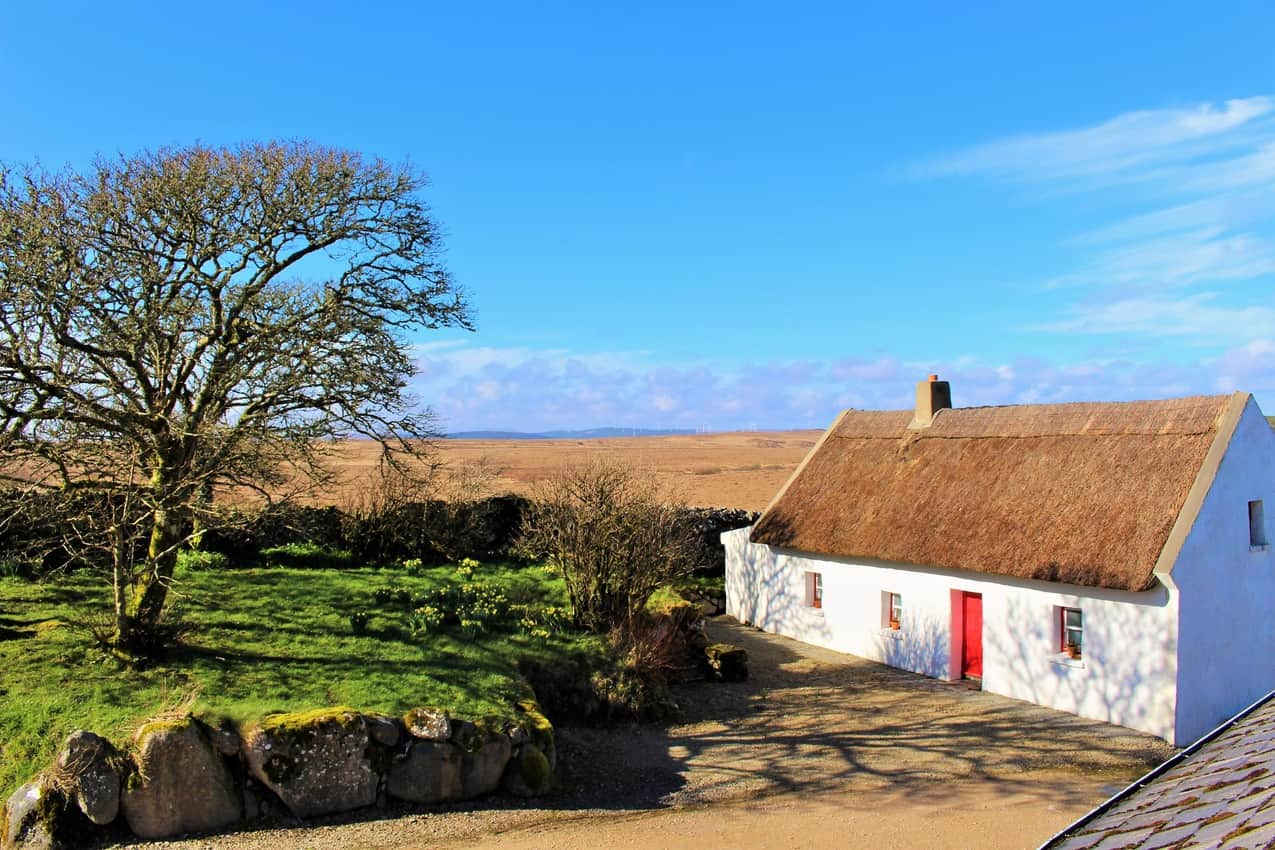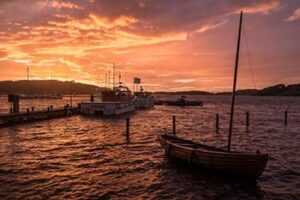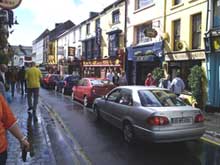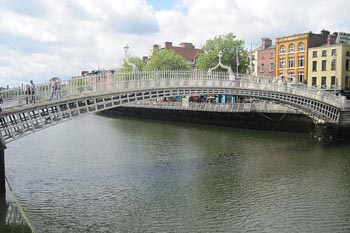
The Legend of the Seven White Ponies and Other Tales from Connemara
By Ginger Warder
Ireland is a land filled with storytellers, and nowhere is this truer than in the West, where Gaelic culture and history seem to be embedded in the bogs and lakes alongside the rocky Atlantic coast, guarded by the mountain range called the Twelve Bens.

The rocky coastline gives way to green fields bisected by stone walls and dotted with yellow gorse bushes—many fields contain the ruins of stone cottages, castles or abbeys.
In the spring, the fields in Ireland are also filled with tiny lambs, napping in the sun or gamboling after their mothers. Daffodils dot the roadside at random and cattle roam on the hillsides.
Waking up the Villages
Small seaside villages are awakening after a long, cold winter and their pubs and restaurants are once again welcoming visitors with oysters, mussels, and salmon from the icy Atlantic waters.
The weather—influenced by the whims of the Atlantic Ocean and the Gulfstream—is always unpredictable. In one short hour, we went from sunshine to rain to a rainbow to heavy hail, ending with a few snowflakes.
Many of the stories you’ll hear in the West are tragic and true, while some are fanciful folklore born from a seed of truth. You’ll hear them in Irish songs that tell of the years of war and famine. You’ll hear them in the poetry of Yeats and Kavanagh and in the works of Oscar Wilde and James Joyce.
And while you might hear these tales from a professional tour guide, you’re also just as likely to hear them from a stranger over a pint in the pub.
Tragic or triumphant, melancholy or magical, the Irish embrace their history like a lover, be it sad or joyful. Here are a few of the tales I heard on a recent visit to Connemara.
The Wild Ponies of Connemara
“The old folk will tell you that ponies still go back
And forth between here and Tír na nÓg.
But you’ll never discover the way.
You see, you don’t find the ponies, they find you.”
Tony Curtis/ Where Do I Go to Find a Connemara Pony?
As we wound our way through Connemara, our tour guide, Will Collins, told us to keep an eye out for the wild ponies. Ireland’s only unique horse breed, the hardy Connemara pony is native to this region. Most likely, they are a cross between ponies that came with the Spanish Armada and the Scandinavian ponies brought over by the Vikings.
The hardy ponies were often used in farming, pulling plows or transporting loads of cut turf or seaweed. Known for their gentle temperament, many of them were domesticated and today, there are fewer wild ponies roaming the lands of Connemara.

Single Females and Ponies
As we passed field after field, Collins told the single females in the group to keep an eye out for the white ponies. He said that if an unmarried woman saw seven white ponies in one day, she would meet the man she would marry within one year.
For the following three days, we called out pony sightings from the bus and kept a tally. On the third day, I finally saw seven white ponies!
And while Collins is a true master of the history of the region—and Irish ephemera in general—he finally confessed that the “legend” was more fiction than fact. I have to admit I was a bit disappointed, as I was looking forward to a year of mystery and fun, looking for my special “someone”.
However, it is true, as the poetry of Tony Curtis describes, that these white and grey ponies have a mystical quality:
“The Lord of bog, mountain, lakes rivers
Is the Connemara Pony-
Who would disappear into mist with one?”
And in a land of leprechauns and fairies, rainbows and pots of gold, it’s easy to believe in the magic of the wild ponies.
The Ballad of Dan O’Hara
In the year of sixty-four
I had acres by the score
And the grandest land you ever ran a plow through
But the landlord came you know
And he laid our home so low
So it’s here I am today your broken-hearted
Achusla geal mo chroi*, won’t you buy a box from me
And you’ll have the prayers of Dan from Connemara
I’ll sell them cheap and low, buy a box before you go
From the broken-hearted farmer Dan O’Hara
Delia Murphy
Martin Walsh, the owner of the Connemara Heritage Centre, is the quintessential Irish storyteller. His farm includes what was once the hillside farm and cottage of a tenant farmer, Dan O’Hara—today the centerpiece of the Heritage Centre. Martin hooked his big tractor to a trolley and hauled us up the hillside to O’Hara’s small stone cottage and as we stood around the fireplace, he told us this sad story.
In the mid-1800s, tenant farmers like Dan O’Hara were not allowed to make home improvements and there were restrictions on the size and height of doors and windows. Walsh said the doors had to be so short that you had to “bow” to get through them, thus making tenants pay homage to the British rulers.
There was also a tax on windows—the origin of the saying “daylight robbery”—but the rebellious O’Hara increased both his door height and the size of his windows to make his family more comfortable. In 1845, he and his family were evicted and had to flee to America on what was known then as “coffin ships” for the appalling conditions and rampant diseases that were common.

Wife and Children Died
O’Hara’s wife and three of his children did not survive the voyage and O’Hara ended up penniless on the streets of New York selling matches. At this point, Martin burst into song, treating us to the poignant ballad of Dan O’Hara.
When he finished the song, he reached into a recess behind the mantle to unearth some “illegal” Irish whiskey called poitín. He filled our shot glasses and we drank a toast to the sad fate of Dan O’Hara and all those who suffered during those hard years of famine and foreign rule.
The Transatlantic Flight of Alcock & Brown
Derrigimlagh Bog is one of the major attractions on the Wild Atlantic Way. Filled with small lakes, rich peat and a variety of flora and fauna, the bog was also home to two history-making events in the 20th century.
In October 1907, the first commercial transatlantic message was transmitted from Guglielmo Marconi’s wireless telegraph station in Clifden—located on the edge of the bog—to Glace Bay, Newfoundland, Canada.
Twelve years later, in 1919, it was the tall masts at Marconi’s station that guided pilots John Alcock and Arthur Brown to land their Vickers-Vimy biplane after their record-setting and prize-winning 16-hour transatlantic flight from Newfoundland to Ireland’s coast.
They saw what they thought was a wide-open green field behind the transmitting station and set the plane down. Unfortunately, they landed in the bog and the plane immediately began to sink. The pilots scrambled to safety and won the £10,000 prize from the Daily Mail—awarded by none other than Winston Churchill—but lost their plane.
Grabbing What They Could
John O’Halloran, our local guide in Clifden and an expert on the bog, said the townspeople grabbed whatever parts of the airplane they could get their hands on as it was sinking, and he claims that today, there are still homes boasting a literal piece of aviation history on display over their mantles or on their walls.
Although Marconi’s station burned down during the Irish War of Independence and the plane sits at the bottom of the bog, these two historic feats have made preserving the Derrigimlagh Bog even more important. From an environmental standpoint, it’s one of the largest blanket bogs remaining in the world and for that alone, it is worth saving.
Today, visitors can take the Derrigimlagh Loop Walk—an easy 5 km stroll— around points of historical importance, including the ruins of the Marconi station and a wing-shaped memorial to Alcock and Brown. The two-hour walk is suitable for all ages and much of it is accessible by a boardwalk that accommodates strollers and wheelchairs.
But if you really want a great experience, O’Halloran’s guided walk really brings these stories to life and there’s nothing like hearing it from an Irish local.
As for the historic airplane parts displayed in local homes, you’ll have to befriend someone in the local pub to get a glimpse of those.
Castles and Cottages with Stories
Forget getting a room with a view. Get a room with some history and chances are you’ll get the view as well. Connemara’s castles and hillside cottages are historical treasures, in and of themselves.
Abbeyglen Castle

Built in 1832, you would never guess that this ornate manor house served as an orphanage for decades. With luxurious suites filled with both antiques and all the modern amenities a 21st-century traveler could desire, you certainly won’t feel deprived. The hotel also boasts an excellent restaurant and is within walking distance of Connemara’s capital, Clifden.
Ballynahinch Castle
At first glance, Ballynahinch Castle—considered to be one of the best resorts in Ireland—is underwhelming. That’s because this 700-acre estate is a sportsman’s paradise, attracting hunters, hikers and fly fishing aficionados from around the world.
The unpretentious décor in the common areas is rustic, with comfortable couches and cozy fireplaces.
The Fisherman’s Pub, appropriately filled with fishing memorabilia and photos of guests with their great catches throughout the years is where guests wind down after the day’s adventures and tell a few tall tales of their own.
However, the rooms overlooking the river and salmon fishery, as well as the critically acclaimed restaurant are truly elegant—and befitting of the phrase “to the manor born.”
Cnoc Suain
For a truly authentic experience—and a taste of time travel—stay at the 17th-century living history hill village, Cnoc Suain (pronounced kah-nook soon). The lovingly restored stone cottages are surrounded by 200 acres of bogland, wild heather, and hedgerows and you may even spot a Connemara pony or two.
The husband and wife team of Charlie Troy and Dearbhaill Standun—both teachers—share their passion for the Gaelic culture through a variety of interactive programs focused on the music, food, and traditions of the region. Their passion for preservation and sustainability, combined with education, have earned Cnoc Suain several international awards for eco-tourism.
Connemara is the heart of the Irish Gaeltacht, (Irish speaking area) and if you truly want to know and understand Ireland, you must experience its authentic culture and hear its stories.
Chances are, you’ll come home with a few stories of your own.
Useful Links to Connemara Ireland
Ireland Tourism https://www.ireland.com
Visit Connemara https://www.connemara.net/
Connemara Heritage Center and Dan O’ Hara’s Cottage http://www.connemaraheritage.com/
Derrigimlagh Bog Looped Walk https://guidetoconnemara.com/item/derrigimlagh-looped-walk/
https://www.wildatlanticwayonline.com/galway-wild-atlantic-way/discovery-points/derrigimlagh-bog/
Abbeyglen Castle https://www.abbeyglen.ie/
Ballynahinch Castle https://www.ballynahinch-castle.com/
Cnoc Suain https://www.cnocsuain.com/
Find out more about Connemara from Ireland’s tourism website. The author’s trip was sponsored by the tourism board, but the opinions are the author’s own.
Eurail Passes: What to Know about Buying a Europe Train Pass
- Back to the Future in Knoxville, Tennessee - December 14, 2023
- Santee Cooper Country, South Carolina for Fishing and Fun - March 31, 2022
- Connemara, Ireland’s West Coast - April 10, 2020







